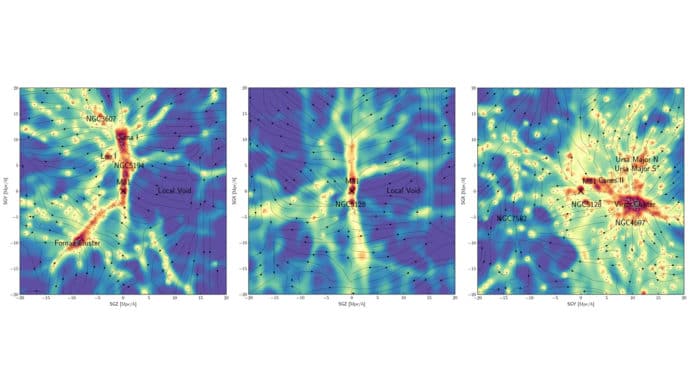Using machine learning, astrophysicists at Penn State have created a new dark matter map in the local universe. This map has revealed previously undiscovered filamentary structures connecting galaxies.
With time, the universe is continually expanding. With this expansion, the universe’s complexity has increased as well; hence it is quite challenging to make measurements about dark matter locally.
In past studies, scientists used a model of- the early universe and evolution over billions of years- to create a map of the cosmic web. Although, this method is computationally intensive and has not been able to produce results detailed enough to see the local universe.
In this new study, astrophysicists used a completely different approach: They used machine learning to build a model that uses information about the distribution and motion of galaxies to predict the distribution of dark matter.
The model was built and trained using a large set of galaxy simulations, called Illustris-TNG. The dataset contains galaxies, gasses, other visible matter, as well as dark matter.
By carefully selecting simulated galaxies comparable to those in the Milky Way, the team was able to identify which properties of galaxies are needed to predict the dark matter distribution.
Donghui Jeong, associate professor of astronomy and astrophysics at Penn State and a corresponding author of the study, said, “When given certain information, the model can essentially fill in the gaps based on what it has looked at before. The map from our models doesn’t perfectly fit the simulation data, but we can still reconstruct very detailed structures. We found that including the motion of galaxies — their peculiar radial velocities — in addition to their distribution drastically enhanced the quality of the map and allowed us to see these details.”
The model was then applied to the real data from the local universe from the Cosmicflow-3 galaxy catalog. The catalog contains comprehensive data about the distribution and movement of more than 17 thousand galaxies in the vicinity of the Milky Way — within 200 megaparsecs.
The map successively reproduced known prominent structures in the local universe, including the “local sheet” — a region of space containing the Milky Way, nearby galaxies in the “local group,” and galaxies in the Virgo cluster — and the “local void” — a relatively empty region of space next to the local group. Additionally, it identified several new structures that require further investigation, including smaller filamentary structures that connect galaxies.
Jeong said, “Having a local map of the cosmic web opens up a new chapter of cosmological study. We can study how the distribution of dark matter relates to other emission data, which will help us understand the nature of dark matter. And we can study these filamentary structures directly, these hidden bridges between galaxies.”
“Studying the dark matter filaments connecting the two galaxies could provide important insights into their future.”
“Because dark matter dominates the dynamics of the universe, it determines our fate. So we can ask a computer to evolve the map for billions of years to see what will happen in the local universe. And we can evolve the model back in time to understand the history of our cosmic neighborhood.”
By adding the data of more galaxies, scientists are looking forward to improving the accuracy of the map.
This research was supported in part by the National Research Foundation of Korea funded by the Korean Ministry of Education, the Korean Ministry of Science, the U.S. National Science Foundation, the U.S. National Aeronautics and Space Administration Astrophysics Theory program, and the Center for Advanced Computation at the Korea Institute for Advanced Study.
Other co-authors of the study include Sungwook Hong at the University of Seoul/Korea Astronomy and Space Science Institute in Korea, Ho Seong Hwang at the Seoul National University in Korea, and Juhan Kim the Korea Institute for Advanced Study.
Journal Reference:
- Sungwook E. Hong, Donghui Jeong, Ho Seong Hwang, Juhan Kim. Revealing the Local Cosmic Web from Galaxies by Deep Learning. The Astrophysical Journal, 2021; 913 (1): 76 DOI: 10.3847/1538-4357/abf040
